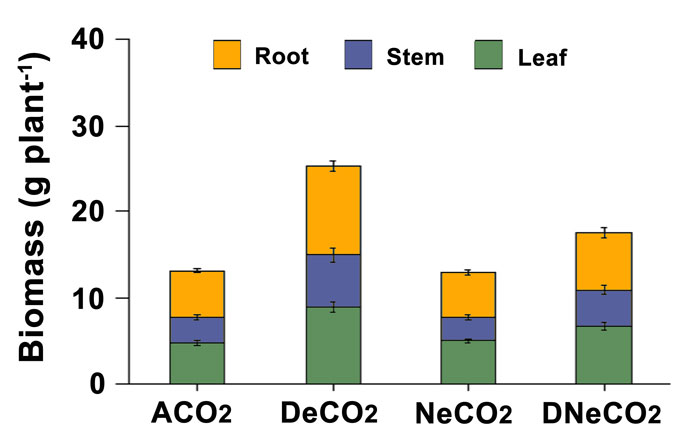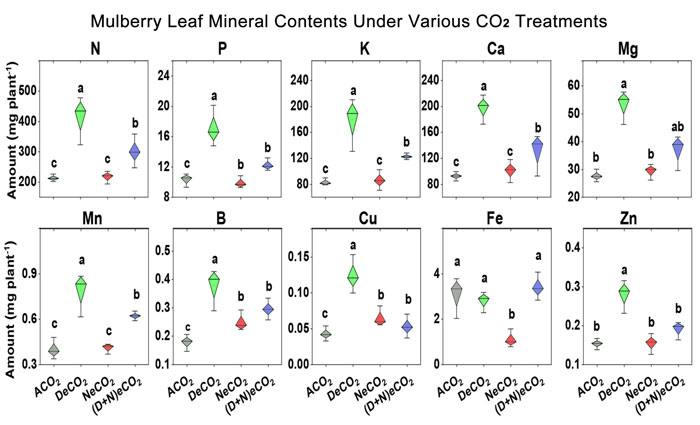Mulberry Seedling Response to Short-term CO2 Enrichment
Shi, S., Qui, Y., Wen, M., Xu, X., Dong, X., Xu, C. and He, X. 2021. Daytime, not nighttime, elevated atmospheric carbon dioxide exposure improves plant growth and leaf quality of Mulberry (Morus alba L.) seedlings. Frontiers in Plant Science 11: 609031, doi: 10.3389/fpls.2020.609031.
Introducing their study, Shi et al. (2021) write “as atmospheric CO2 is the primary source of carbon (C) for plants, the ongoing increased CO2 will act as a C fertilizer, resulting in an increase in biomass production in cereal crops, vegetable crops, perennial fruit crops, grass, and some perennial woody plants,” citing multiple studies in support of this statement. As their contribution to the literature, the team of seven scientists evaluated the growth response of mulberry (Morus alba, cv. Gui-sang-you 62) seedlings to different day and night combinations of CO2 enrichment.
The work was performed at the campus of Southwest University, Chongqing, China, where the researchers constructed environment-controlled glass chambers in which they exposed six-month-old seedlings to four CO2 treatments over a period of 120 days. The four treatments included different daytime (0730-1930 hrs) and nighttime (1930-0730 hrs) levels of CO2 exposure, including (1) an ambient treatment of 410 ppm during the day and 460 ppm at night, (2) daytime only elevated CO2 (abbreviated DeCO2) with daytime CO2 elevated to 710 ppm, (3) nighttime only elevated CO2 (abbreviated NeCO2) with nighttime CO2 elevated to 760 ppm, and (4) full elevation of CO2 during day and night hours (abbreviated DNeCO2) with daytime and nighttime CO2 elevated to 710 ppm and 760 ppm, respectively. And what did their experiment reveal?
First off, as illustrated in Figure 1, elevated CO2 enhanced the root, stem and leaf biomass in the daytime only (DeCO2) and day and night (DNeCO2) CO2 treatments such that their total plant biomass was 40% and 113% greater than that observed in the ambient treatment. In contrast, nighttime only CO2 enrichment had no effect on any of these parameters, which is of little surprise given that the photosynthesis process requires sunlight. Next, Shi et al. report “the amounts of leaf N, P, K, Ca, Mg, Mn, B, Cu, Fe and Zn were significantly increased under either [the] DeCO2 or DNeCO2 [treatments]” (see Figure 2). Furthermore, they found elevated CO2 (except the NeCO2 treatment) stimulated “accumulations of leaf carbohydrates (starch, soluble sugar and fatty acid) and N-containing compounds (free amino acid and protein), though there were some decreases in the concentration of leaf N, P, Mg, Fe and Zn” (emphasis added). And in light of all these findings, the authors’ could not have summed up their work better than what they did in the title of their paper by noting elevated atmospheric carbon dioxide exposure “improves plant growth and leaf quality of mulberry seedlings.”

Figure 1. Plant biomass production of mulberry seedlings grown for 120 days under different daytime and nighttime CO2 concentrations. ACO2 = ambient CO2 (410/460 ppm daytime/nighttime), DeCO2 = daytime only elevated CO2 (710/460 ppm daytime/nighttime), NeCO2 = nighttime only elevated CO2 (410/760 ppm daytime/nighttime), DNeCO2 = continuous daytime and nighttime elevation of CO2 (710/760 ppm daytime/nighttime). Daytime spanned 0730-1930 hours and nighttime spanned 1930-0730 hours. Source: Shi et al. (2021).

Figure 2. Accumulations (contents) of leaf macro-micro elements in mulberry seedlings grown for 120 days under different daytime and nighttime CO2 concentrations inside environmentally controlled glass growth chambers. Different letters indicate significant differences among CO2 treatments at P < 0.05. See treatment abbreviations in Figure 1. Source: Shi et al. (2021).
This article appeared on the CO2 Science website at http://www.co2science.org/articles/V24/may/a3.php
]]>